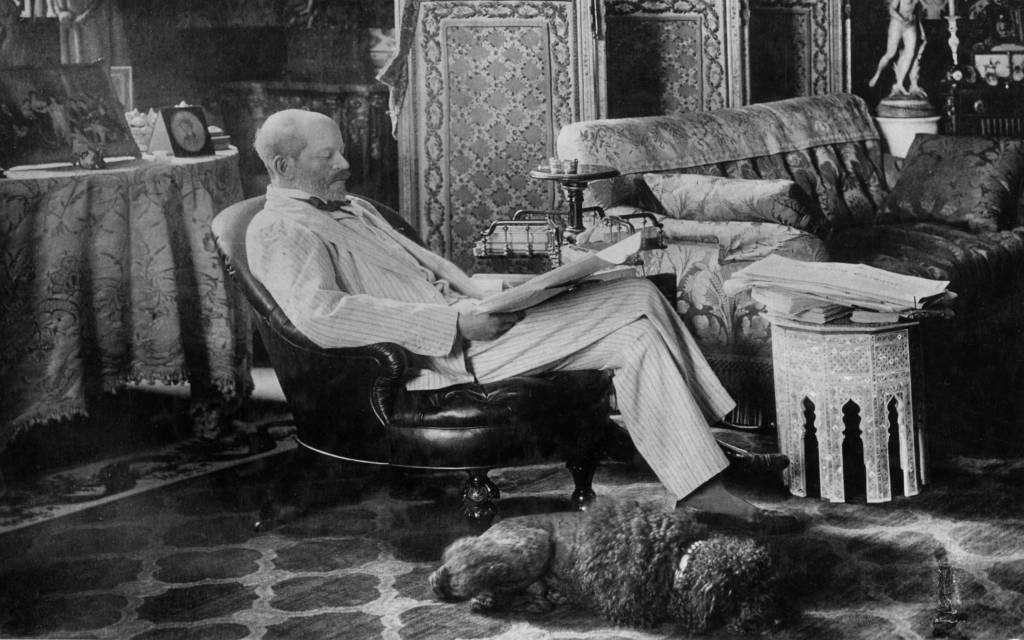
The Red Book
One of the key sources we have relating to Waddesdon during Baron Ferdinand's time is Waddesdon's Red Book.
The Red Book is an album of photographs along with a short essay by Ferdinand on the process of creating Waddesdon.
“I dedicate this album to my Friends, who have taken a sympathetic interest in the growth and development of Waddesdon, and trust it may be acceptable to them in remembrance of their visits to my now completed house…”
From the dedication it seems likely that Ferdinand had the album printed as presents for his friends and family. We know of two further copies in other collections, only one of which is bound in red leather, but do not know how many there originally were. The photographs used to illustrate the Red Book give us a fascinating record of the way Ferdinand furnished his house. They show the location of everything from paintings and furniture to carpets and porcelain. Many of these items are still in the collection today and we have used the images of the Baron’s Sitting Room to recreate the interior as it was then. Other photographs show the layout of rooms in the Bachelors’ Wing before it was reorganised following the removal of the items from Ferdinand’s Renaissance collection that he bequeathed to the British Museum.

The rest of the essay describes the building process and the huge amount of work that was necessary to transport stone and building materials to a bare hilltop six miles from the nearest railway line. “The stone for the house, which came from Bath, and most of the bricks, which came from all parts of the country, were conveyed on a temporary steam tram from the railway direct to the foot of the hill, up which the trucks were drawn on rails by a cable engine. Other materials for the building, as well as for the farmsteads, cottages, and lodges, and the trees and the shrubs, had to be carted some miles by road.” Ferdinand outlines elements of the process of creating Waddesdon. He talks about his choice of the site and how it was far from ideal but a lack of suitable alternatives led him to making an offer despite its defects. He then describes his choice of the French architect, Destailleur, to design the house and his compatriot, Lainé, to design the gardens. The design process was a long one and Ferdinand had to curtail his architect’s flights of fancy leading to the following comment: “You will regret your decision,’ he said to me at the time, ‘one always builds too small.’ And he prophesied truly. After I had lived in the house for a while I was compelled to add first one wing and then another…”
The creation of the gardens and landscaping of the estate involved almost as much work including the removal of huge amounts of soil to level the incline on the carriage drives and roadways. It must have been an amazing sight to see the plants and trees transported to Waddesdon to cover the the once bare hillside:”Percheron mares…were employed principally in connection with the cartage of large trees which were brought from all parts of the neighbourhood, and for the moving of which on to the highways the telegraph wires had to be temporarily displaced.” The information Ferdinand gives about the creation of Waddesdon gives us an indication of just how much effort it took to create his masterpiece, not just the process of building the house but also of building up a unified and consolidated estate through the purchase of land from neighbouring landowners. As he makes clear in one story about the purchase of land from a particularly stubborn farmer he was not beyond a bit of gentle manipulation when necessary.

He finishes the Red Book with a rather dismal comment on what the future might hold:
“A future generation may reap the chief benefit of a work which to me has been a labour of love, though I fear that Waddesdon will share the fate of most properties whose owners have no descendants, and fall into decay. May the day be yet distant when weeds will spread over the gardens, the terraces crumble into dust, the pictures and cabinets cross the Channel or the Atlantic, and the melancholy cry of the night-jar sound from the deserted towers.”
Thankfully, his fears proved groundless, and Waddesdon continues to thrive!
Posted by Catherine Taylor, Head Archivist.



